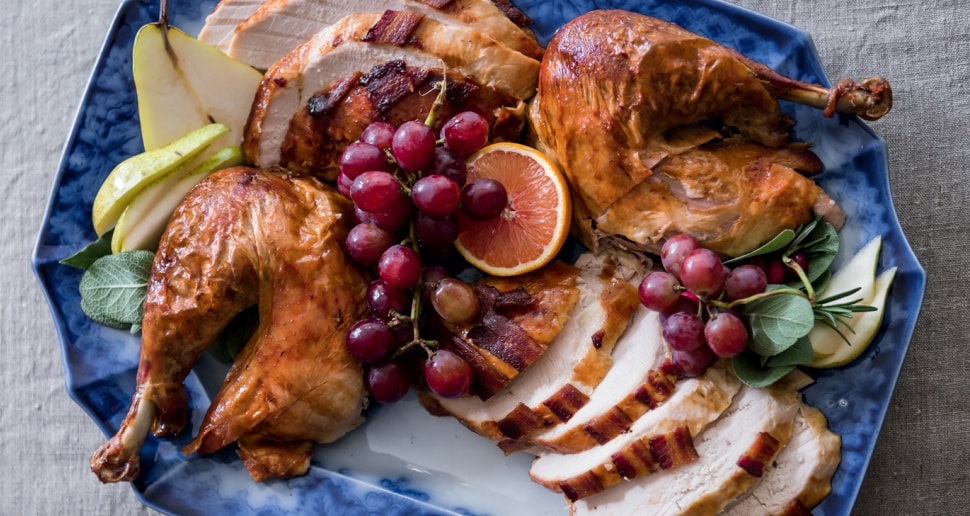Maple-Bacon Dry-Cured Turkey
Dry brining your Thanksgiving turkey with salt, herbs, and a bit of maple sugar provides all the benefits of wet brining without the mess, while draping the breast meat with bacon not only adds flavor, but turns the turkey into a self-basting bird.

Maple-Bacon Dry-Cured Turkey
Photo Credit : Krissy O'SheaDry brining (really just a fancy version of pre-salting) provides all the benefits of wet brining (enhanced flavor, juicier meat) without the mess. You simply coat the turkey with salt, herbs, and a bit of maple sugar and let it sit in the refrigerator for at least one day and preferably three. The good news: If your turkey is frozen, you can thaw and brine at the same time. Draping the breast meat with bacon (a trick that food editor Amy Traverso learned from her grandmother) not only adds flavor but also turns the turkey into a self-basting bird.
Be sure to buy a “natural,” untreated turkey for this recipe. Many frozen and kosher turkeys come pre-salted, so adding the step of dry-curing would result in much-too-salty meat. If you find yourself with such a bird, however, just skip the salt rub, lay the bacon over the breast, and proceed according to instructions.
For the Turkey
Ingredients
1/4 cup kosher salt
1/4 cup maple sugar (or 3 tablespoons firmly packed dark brown sugar)
3 tablespoons dried marjoram
2 tablespoons dried rubbed sage
2 tablespoons juniper berries
1 tablespoon black peppercorns
1 fresh, untreated medium turkey (13 to 15 pounds)
6 strips thick-cut bacon, uncooked
1 large onion, quartered
5 sprigs fresh sage
3 1/2 cups low-sodium chicken stock, divided
1/4 cup maple syrup (any grade)
Instructions
Three days before cooking, prepare your turkey. First, use a blender or spice grinder to finely grind the salt, maple (or brown) sugar, marjoram, sage, juniper berries, and peppercorns. Set aside.
Next, get the bird ready for dry-curing. Remove excess lumps of fat. Take out the giblets and neck. Rub the herb mixture over the entire bird; sprinkle some in the body cavity as well. Place the turkey, breast-side up, in an extra-large, food-grade plastic bag.
Seal and refrigerate for three days, turning the bird breast-side down on the second day. The night before you plan to roast the turkey, remove it from the bag, set it breast-side up on a rack in your roasting pan, and refrigerate. (This produces crispier skin.)
An hour before you begin roasting, remove the bird from the refrigerator. Lay the bacon strips across the breast, letting them overlap slightly. Stuff the body cavity with onion and sage. Tie the legs with kitchen twine.
Preheat the oven to 325° and set a rack to the lower third position. Pour 2 cups of the broth into the bottom of the pan and transfer it to the oven. Roast for 1¾ hours, then add broth as needed to maintain some liquid in pan. The turkey will be done when an instant-read thermometer inserted into the thickest part of the thigh registers 160°, 2½ to 3 hours total. About 45 minutes before the turkey is done, add the maple syrup to the pan and baste once (tent the bird with foil if it is browning too quickly). Remove the bird from the oven and tip it to drain juices from the cavity into the roasting pan. Transfer the bird to a platter and let rest, uncovered, about 30 minutes before carving.
For the Gravy
Ingredients
Drippings from the roasting pan
2/3 cup all-purpose flour
4 cups low-sodium chicken or turkey stock, plus more as needed
1 tablespoon bourbon
Kosher salt and freshly ground black pepper, to taste
Instructions
Meanwhile, make the gravy: Drain off about ¾ of the fat from the drippings. Set the roasting pan with the remaining drippings over two burners on your stove and set both to medium heat. Whisk in the flour until smooth. Gradually whisk in 4 cups stock, picking up any browned bits from the bottom of the pan. Add the bourbon and cook, stirring, until the gravy is thickened and smooth (if needed, run it through a strainer). If the gravy seems too thick, add a bit more stock. Season with salt and pepper to taste. Carve the turkey and serve with the gravy.


